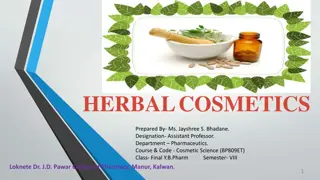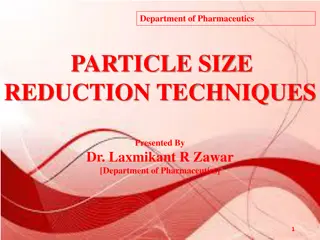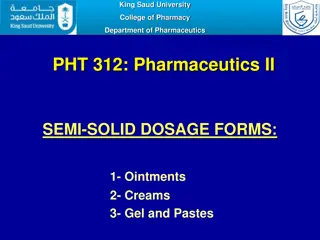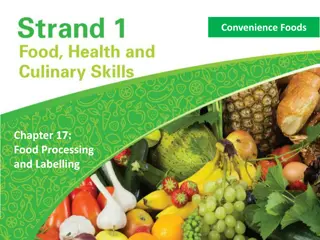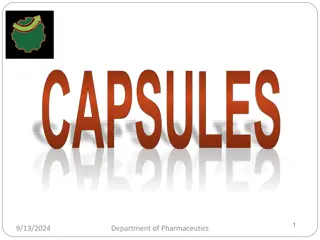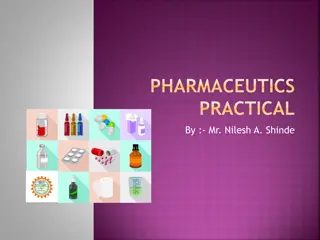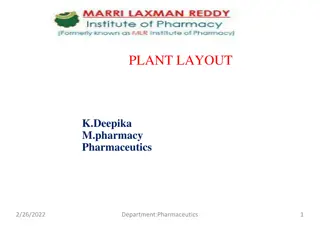Understanding Solutions in Pharmaceutics: Advantages, Disadvantages, and Classification
Solutions in pharmaceutics are liquid preparations containing chemical substances dissolved in a solvent. They can be formulated for different administration routes like oral, parenteral, and topical. While solutions offer benefits like easier swallowing and quicker effectiveness, they also have drawbacks such as bulkiness and stability issues. Classifications include aqueous and non-aqueous solutions, each with specific characteristics. Understanding the nuances of solutions is crucial for pharmaceutical formulation and administration.
Download Presentation

Please find below an Image/Link to download the presentation.
The content on the website is provided AS IS for your information and personal use only. It may not be sold, licensed, or shared on other websites without obtaining consent from the author. Download presentation by click this link. If you encounter any issues during the download, it is possible that the publisher has removed the file from their server.
E N D
Presentation Transcript
Pharmaceutics 1 Liquid dosage forms Solutions 1 1
Solutions In pharmaceutical terms, solutions are liquid preparations that contain one or more chemical substances dissolved in a suitable solvent or mixture of mutually miscible solvents ( aqueous or non aqueous) . It may be classified as oral, otic, ophthalmic, or topical. Certain solutions prepared to be sterile and pyrogen free and intended for parenteral administration are classified as injections. 2
Solutions can be formulated for different routes of administration Orally: Syrups, elixirs, drops Parenterally : IV , IM , SC In mouth and throat: Mouth washes, gargles, throat sprays. In body cavities: Douches, enemas, ear drops, nasal sprays. On body Surfaces: Collodions, lotions. 3
Advantages of SoIutions (1) Easier to swallow therefore easier for: children - old age - unconscious people. (2) More quickly effective than tablets and capsules. (3) Homogenous,, the drug will be uniformly distributed throughout the preparation therefore give uniform dose compared to suspension or emulsion which need shaking. (4) Some drugs can irritate the gastric mucosa if localized in one area. Irritation is reduced by administration of a solution of the drug 4
Disadvantages of Solutions (1) Bulky therefore difficult to transport and store. (2) Unpleasant taste or odours are difficult to mask. (3) Needs an accurate spoon to measure the dose. (4) Less stable than solid dosage forms. major signs of instability: colour change, precipitation microbial growth chemical gas formation 5
Classification of Solutions According to Vehicle (a) Aqueous solutions (b) Non-aqueous solutions 6
Aqueous Solutions Aqueous solutions are homogeneous mixtures that are prepared by dissolving a solid, liquid or gas in an aqueous medium (vehicle). Vehicle: This may be water, aromatic water or extracts. None- Aqueous Solutions 1. alcoholic or hydroalcoholic solutions, e.g. elixirs and spirits, 2. ethereal solutions, e.g. the Collodions 3. glycerin solutions, e.g. the glycerites, 4. oleaginous solutions e.g. the liniments, medicated oils, oleo- vitamins, sprays, and toothache drops. 7
Oral solutions their absorption from the gastrointestinal tract into the systemic circulation may be expected to occur more rapidly than from suspension or solid dosage forms of the same medicinal agent. Solutes other than the medicinal agent are usually present in orally administered solutions. These additional agents are frequently included to provide color, flavor, sweetness, or stability. 8
In formulating or compounding a pharmaceutical solution, the pharmacist must use information on the solubility and stability of each solute with regard to the solvent or solvent system. Combinations of medicinal or pharmaceutical agents that will result in chemical and/or physical interactions affecting the therapeutic quality or pharmaceutical stability of the product must be avoided. 9
For many medicinal agents, their solubility in the usual solvents are stated in the United States Pharmacopeia National Formulary (USP NF) as well as in other reference books. A pharmacist can, in certain instances, dissolve greater quantities of a solute than would otherwise be possible by using Solubilizing agent or a different chemical salt form of the medicinal agent, alteration of the pH of a solution, or substitution in part or in whole of the solvent. Example: iodine in water or an aqueous solution of potassium iodide or sodium iodide as the solvent , much larger amounts of iodine may be dissolved in the second solvent as the result of the formation of a water-soluble complex with the iodide salt. This reaction is taken advantage of, for example, in Iodine Topical Solution, USP, prepared to contain about 2% iodine and 2.4% sodium iodide. 10
Many of the organic medicinal agents are either weak acids or weak bases, and their solubility depends to a large measure on the pH of the solvent. These drugs react either with strong acids or strong bases to form water soluble salts. 11
Pharmaceutical manufacturers have prepared many acid salts of these organic bases to enable the preparation of aqueous solutions , ex (diphenhydramine HCl) , Atropine sulfate Many basic salts of weak acids have been prepared Phenobarbital sodium silver sulfadiazine 12
Water and alcohol solubility of weak acids and weak bases and their salts 13
The rate of solution, that is, the speed at which the substance dissolves, depends on: 1.the particle size of the substance: the finer the powder, the greater the surface area, which comes in contact with the solvent, and the more rapid the dissolving process. 2.the extent of agitation: the greater the agitation, the more unsaturated solvent passes over the drug and the faster the formation of the solution. 14
3. Temperature: heating a liquid also causes solution to take place more rapidly by increasing the frequency which solvent molecules collide with the surface of the dissolving mixture 15
Selection criteria for solvents the selection of the proper solvent for a particular solute: solubility, (like dissolves like) clarity, low toxicity, viscosity, Compatibility with other formulative ingredients, Chemical inertness, palatability, odor, color, economy. 16
SOLVENTS FOR LIQUID PREPARATIONS PURIFIED WATER, USP, H2O Fixed oils ALCOHOL, USP DILUTED ALCOHOL, NF RUBBING ALCOHOL GLYCERIN, USP PROPYLENE GLYCOL, USP 17
SOLVENTS FOR LIQUID PREPARATIONS water In most instances, water is the preferred solvent because it comes closer to meeting these criteria than other solvents. Advantages: Tasteless, odourless, lack of pharmacological activity, neutral and very cheap . Disadvantages: favorable medium for some chemical reactions, and it supports the growth of microorganisms when contaminated. When water is used as the primary solvent, commonly an auxiliary solvent ( Co-Solvents ) is also employed to augment the solvent action of water or to contribute to a product s chemical or physical stability. Alcohol, glycerin, and propylene glycol. 18
PURIFIED WATER, USP, H2O Ordinary drinking water from the tap is not acceptable for the manufacture of most aqueous pharmaceutical preparations or for the extemporaneous prescriptions compounding of because incompatibilities between dissolved solids and the medicinal agents being added. of the possible chemical 19
Purified Water, USP, is obtained by distillation, ion exchange treatment, reverse osmosis, or other suitable process. has fewer solid impurities than ordinary drinking water. When evaporated to dryness, it must not yield more than 0.001% of residue (1 mg of solids per 100 mL of water). 20
Purified Water, USP intended for use in the preparation of aqueous dosage forms except those intended for parenteral administration (injections). Water for Injection, USP; Bacteriostatic Water for Injection, USP; or Sterile pyrogen free Water for Injection, USP, is used for injections. 21
SOLVENTS FOR LIQUID PREPARATIONS Fixed oils A number of fixed oils, such as corn oil, cottonseed oil, peanut oil, and sesame oil, are useful solvents, particularly in the preparation of oleaginous injections. Intramuscular injection (IM( Rapid absorption from aqueous solution. Slow absorption from nonaqueous (oil) solutions. 22
ALCOHOL, USP: ETHYL ALCOHOL, ETHANOL, C2H5OH Next to water, alcohol is the most useful solvent in pharmacy. It is used as a primary solvent for many organic compounds. Together with water, it forms a hydroalcoholic mixture that dissolves both alcohol- substances. soluble and water-soluble Alcohol, USP, is 94.9% to 96.0% C2H5OH by volume (i.e., v/v) when determined at 15.56 C. Dehydrated Alcohol, USP, contains not less than 99.5% C2H5OH by volume and is used when an essentially water- free alcohol is desired. 23
ALCOHOL, USP Certain drugs are insoluble in water and must be dissolved in an alternative vehicle. Alcohol is often preferred because of: 1.its miscibility with water 2.its ability to dissolve many water-insoluble ingredients, including drug substances, flavorants, and antimicrobial preservatives. 24
ALCOHOL, USP Alcohol is frequently used with other solvents, such as glycols and glycerin, to reduce the amount of alcohol required. It is also used in liquid products as an antimicrobial preservative alone or with parabens, benzoates, sorbates. 25
ALCOHOL, USP Undesired pharmacological action and potential toxic effects of alcohol when ingested in pharmaceutical products, particularly by children. Thus, the U.S. Food and Drug Administration (FDA) has proposed that manufacturers of over-the-counter(OTC) oral drug products restrict the use of alcohol and include appropriate warnings in the labeling. insofar as possible 26
ALCOHOL, USP For OTC oral products, the recommended alcohol content limit in product intended for: children under 6 years of age, the recommended alcohol content limit is 0.5%; children 6 to 12 years of age, the recommended limit is 5%; children over 12 years of age and adults, the recommended limit is 10%. 27
DILUTED ALCOHOL, NF is prepared by mixing equal volumes of Alcohol, USP, and Purified Water, USP. The final volume of such mixtures is not the sum of the individual volumes of the two components because the liquids contract upon mixing; the final volume is generally about 3% less than what would otherwise be expected. Diluted alcohol is a useful hydroalcoholic solvent in various pharmaceutical processes and preparations. 28
ETHYL ALCOHOL RUBBING ALCOHOL contains about 70% ethyl alcohol by volume, the remainder consisting of water, denaturants with or without color additives and perfume oils, and stabilizers. must contain sucrose octaacetate or denatonium benzoate, bitter substances accidental or abusive oral ingestion. The product is volatile and flammable and should be stored in a tight container remote from fire. that discourage 29
RUBBING ALCOHOL It is employed as: 1.a rubefacient externally and as a soothing rub for bedridden patients, 2.a germicide for instruments, 3.a skin cleanser prior to injection. 4.a vehicle for topical preparations. 30
ISOPROPYL RUBBING ALCOHOL is about 70% by volume isopropyl alcohol, the remainder consisting of water with or without color additives, stabilizers, and perfume oils. It is used externally as: 1.a rubefacient 2.soothing rub 3.as a vehicle for topical products. 31
GLYCERIN, USP (GLYCEROL), CH2OH CHOH CH2OH Glycerin is a clear syrupy liquid with a sweet taste. It is miscible with both water and alcohol. As a solvent, it is comparable with alcohol, but because of its viscosity, solutes are slowly soluble in it unless it is rendered less viscous by heating. Glycerin has preservative qualities and is often used as a stabilizer and as an auxiliary solvent in conjunction with water or alcohol. It is used in many internal preparations. 32
PROPYLENE GLYCOL, USP, CH3CH(OH)CH2OH a viscous liquid, miscible with water and alcohol. It is a useful solvent with a wide range of applications and is frequently substituted for glycerin in modern pharmaceutical formulations. 33
Methods of Preparation of Solutions (a) Simple Solution (b) Solution by Chemical Reaction (c) Solution by Extraction (a) Simple Solution Solutions of this type are prepared by dissolving the solute in a suitable solvent (by stirring or heating). The solvent may contain other ingredients which stabilize or solubilize the active ingredient e.g. solubility of Iodine is 1: 2950 in water however, it dissolves in presence of KI due the formation of more soluble polyiodides (KI.I2 KI.2I2 KI3.I3 KI.4I4).[ Strong Iodine Solution USP (Lugol's SoIution)]. 35
(b) Solution by Chemical Reaction These solutions are prepared by reacting two or more solutes with each other in a suitable solvent e.g. Calcium carbonate and lactic acid used to prepare Calcium lactate mixture. WHY? (c) Solution by Extraction Plant or animal products are prepared by suitable extraction process. Preparations of this type may be classified as solutions but more often, are classified as extractives. 36
PREPARATION OF SOLUTIONS Most pharmaceutical solutions are unsaturated with solute. Thus, the amounts of solute to be dissolved are usually well below the capacity of the volume of solvent employed. The strengths of pharmaceutical preparations are usually expressed in terms of percent strength. 37
Some chemical agents in a given solvent require an extended time to dissolve. To fasten dissolution, a pharmacist may employ one of several techniques, such as: Applying heat, Reducing the particle size of the solute, Using a solubilizing agent, Subjecting the ingredients agitation. to vigorous 39
many medicinal agents are destroyed at elevated temperatures and the advantage of rapid solution may be completely offset by drug deterioration. If volatile solutes are to be dissolved or if the solvent is volatile (as is alcohol), the heat would encourage the loss of these agents to the atmosphere and must therefore be avoided. certain chemical agents, particularly calcium salts, undergo exothermic reactions as they dissolve and give off heat. For such materials, the use of heat would actually discourage the formation of a solution. A pharmacist may choose to decrease the particle size of the solute by comminution (grinding a solid to a fine state of subdivision) with a mortar and pestle on a small scale or industrial micronizer on a larger scale. 40
Stability of solutions Both physical and chemical stability of solutions in their containers is very important A solution must retain its clarity, colour, odour, taste and viscosity over its shelf life. The formulation pharmacist must be wary of chemical interactions between the various components of a solution that may alter the preparation s stability and/or potency. For instance, esters of p-hydroxybenzoic acid (methyl-, ethyl-, propyl-, and butylparabens), frequently preparations, have a tendency to partition into certain flavoring oils . This partitioning effect could reduce the effective concentration of the preservatives in the aqueous medium of a pharmaceutical product below the level needed for preservative action. used preservatives in oral 41
DRY MIXTURES FOR SOLUTION A number of medicinal agents, particularly certain antibiotics, e.g., penicillin V, have insufficient stability in aqueous solution to meet extended shelf-life periods. Thus, commercial manufacturers of these products provide them to the pharmacist in dry powder or granule form for reconstitution with a prescribed amount of purified water immediately before dispensing to the patient. The dry powder mixture contains all of the formulative components, including drug, flavorant, colorant, buffers, and others, except for the solvent. 42
Once reconstituted by the pharmacist, the solution remains stable when stored in the refrigerator for the labeled period, usually 7 to 14 days This is a sufficient period for the patient to complete the regimen usually prescribed. in case the medication remains after the patient completes the course of therapy, the patient should be instructed to discard the remaining portion, which would be unfit for use at a later time. 43
ORAL REHYDRATION SOLUTIONS Rapid fluid loss associated with diarrhea can lead to dehydration accompanied by depletion of sodium, potassium, and bicarbonate ions. (Na+, K+ & HCO3 -.) Replace the lost fluid & electrolytes with an oral rehydration solution to avoid dehydration. These are OTC products effective in patients with mild volume depletion of 5 10% of body weight. 44
The active absorption of glucose in the smooth intestine ( even during diarrhea) promotes: glucose absorption is coupled with Na+ absorption Na+ promotes anion (X-) absorption, NaX absorption promotes H2O absorption. 45
To produce maximal absorption of sodium and water, studies have demonstrated that the optimal concentrations of glucose and sodium in an isotonic solution are 1. Glucose: 110 mM 2% w/v. 2. Na+: 60 mEq/L. 3. Bicarbonate and/or citrate ions are also included in these solutions to help correct the metabolic acidosis caused by diarrhea and dehydration. 46
1. 2. 3. 4. 5. A typical oral rehydration solution contains: 45 mEq Na+, 20 mEq K+, 35 mEq Cl-, 30 mEq citrate, 25 g of dextrose per liter. These formulations are available in liquid or powder/ packet form for reconstitution. It is important that the user add the specific amount of water needed to prepare the powder forms. these products should not be mixed with or given with other electrolyte-containing liquids, such as milk or fruit juices. otherwise there is no method to calculate how much electrolyte the patient received. 47
SYRUPS Syrups preparations of a sugar or sugar substitute with or without flavoring agents and medicinal substances. are concentrated aqueous pic3 Antihistamine Syrup Acetaminophen Syrup Cough and Cold Syrup 48
SYRUPS Syrups containing flavoring agents but not medicinal substances are called flavored vehicles (non-medicated syrups) (simple syrup) . These syrups are intended to serve as: Pleasant tasting vehicles for medicinal substances to be added in the extemporaneous prescriptions or in the preparation of a standard formula for a medicated syrup, which is a syrup containing a therapeutic agent. compounding of 49




